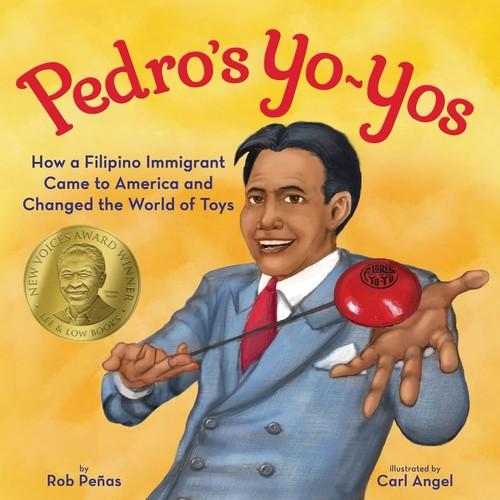Carl Angel
6 Reviews
(2)
K-3
Illustrated by
Carl Angel.
Born in 1896 under Spanish colonial rule in the Philippines, Pedro Flores immigrated to the United States as a teenager. It wasn't until years later -- after he had worked in Hawaiian pineapple fields, on steamships in the Pacific, and at a hotel in California -- that he produced the first Flores yo-yo. Though Flores did not invent the toy (Peñas traces its origins back thousands of years to China), his ingenious reengineering of it led to its rise in popularity (the word yo-yo means "come back" in Tagalog). Peñ as's straightforward text is well supported by deeply saturated images that illustrate Flores's experience as an immigrant: long hours of physically demanding labor and the dogged pursuit of education. It was with the help of a neighbor that Flores was able to start his business, and he committed to bringing his fellow kabayan into his success, as employees. Readers will delight in learning (or remembering) how to "Rock the Baby," "Loop the Loop," and "Walk the Dog." An author's note provides history about the Philippines, the yo-yo, and Flores's life.
Reviewer: Gabi K. Huesca
| Horn Book Magazine Issue:
May, 2024
(3)
K-3
Illustrated by
Carl Angel.
Young Maggie Gee worshiped Amelia Earhart and aspired to become a pilot. In this picture book biography, a cheerful first-person narrative (with invented dialogue) follows Gee's maturation from young dreamer to one of two female Chinese American service pilots in WWII. Vivid acrylic and colored-pencil illustrations emphasize the power of determination. An author's note and archival photographs provide further information.
Reviewer: Chelsey Philpot
(4)
K-3
Translated by Eloisa D. de Jesús.
Illustrated by
Carl Angel.
On a walk through his neighborhood, Lakas meets several street performers and follows one of them--the Karaoke King--home to the Makibaka Hotel. While there, he discovers that the residents are being evicted and rallies them to protest. The tropically hued illustrations have plenty of bounce, and while the bilingual (English and Tagalog) story is wordy, its themes and context are unique.
Reviewer: Roger Sutton
(3)
K-3
Illustrated by
Carl Angel.
Based on a true incident in San Francisco's Mission District, this bilingual story is written by Salvadoran-American poet Argueta. The acrylic, colored-pencil, and photo collage illustrations bring this long story about the dreams of one Salvadoran-American family to life. This is a fine example of what a book with a bilingual text can and should be.
Reviewer: Tim Wadham
(2)
K-3
Translated by Eloisa D. de Jesus.
Illustrated by
Carl Angel.
In this bilingual English/Tagalog story, a boy's father takes him to buy a fish in a shop in Manilatown, San Francisco's historic Filipino-American neighborhood. After speaking to the boy, the fish runs off, with the boy, his father, and the fish-store man in hot pursuit. Kids will be captured by the loopy story and the rollicking, high-colored, bang-bang pictures.
(4)
K-3
Illustrated by
Carl Angel.
When Willie needs to bring a bank into school, his father provides him with an old coconut bank from his childhood in the Philippines; the bank has a special surprise inside--a Willie Mays baseball card. Willie's struggles with feeling different and being bullied are wrapped in a warm tale that introduces a few details from Filipino culture. The illustrations effectively capture Willie's emotions but are often stiff and awkward.
Reviewer: CHristine Sarrazin
6 reviews
We are currently offering this content for free. Sign up now to activate your personal profile, where you can save articles for future viewing.









